Wayne Manor is the stately residence of billionaire Bruce Wayne, secretly Batman. Under all the expensive china and bookcases, it also serves to hide the massive underground cave used as Batman's base of operations, the Batcave.
History of the estate[]
The Wayne family has owned the property since the 19th century, but construction was abandoned after Joshua Wayne died. Jonah Hex held criminal cabals on the grounds. Alan Wayne decided to fully construct a mansion on the acreage.
Bruce discovers the cave as a child[]
While playing on the property, Bruce fell through rotting wood covering an old well that drew water from the cave. Injured and feeling vulnerable, he was quickly frightened by the bats that had been sleeping there. This was a highly traumatic for Bruce Wayne, he was only comforted by his mother Martha after Dr. Thomas Wayne scolded him for being foolish.
Return from training abroad[]
When Bruce first returned to the mansion, he kept his small crime lab in his father's study. After the Window Bat appeared to him there he decided it was time to return to the cave he fell into as a child. After exploring the cave with Alfred he realized it was the perfect place to hide his vigilante equipment.[1]
Vacancy in the 1970's[]
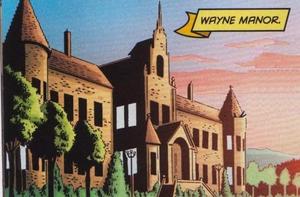
Wayne Manor before the earthquake.
Bruce Wayne decided to vacate the property after his ward left for college. Bruce and Alfred moved into a penthouse apartment on top of the Wayne Foundation Building in the heart of the city, which also included a secret sub-basement acting as a Batcave.[2] Wayne returned to his ancestral home in 1982 (Detective Comics #513) over a decade later.
Following the events of Cataclysm[]
During the events of Batman: Cataclysm a massive earthquake struck Gotham City, the epicenter of which was less than a mile from Wayne Manor. The mansion was seriously damaged, as was the cave network beneath. The ground beneath the mansion shifted significantly, and actually revealed the Batcave below. The original Manor was damaged beyond repair, forcing Bruce Wayne to redesign the Manor along with the Batcave. The new Manor is a veritable fortress, a pastiche of Gothic architecture combined with features of castellated architecture. Solar panels are installed in the new Manor, providing environmentally-friendly electricity generation for the complex. It also includes a heliport for commercial helicopters. Following the events of Arkham Asylum's collapse in Batman Eternal #29, Wayne Manor was donated by Bruce Wayne to replace the institution in Arkham Manor #1. After reconstruction, the Manor was renamed "Arkham Manor" and began housing the Arkham Inmates. The doctors note that Arkham Manor is even more secure than the original Asylum. The entrance to the Batcave was sealed off with a wall of cement to prevent anyone from discovering or accessing the Batcave.
Bruce's private study[]
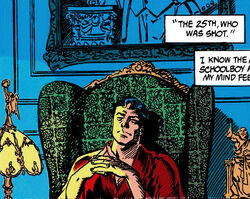
Bruce sits in the dark.
Bruce Wayne has extensive library and spends much his spare time here to collect his thoughts. This is where a large bat flew threw a window, inspiring his bat-uniform.
Access to the Batcave[]
The Manor grounds include an extensive subterranean cave system that Bruce Wayne discovered as a boy and later used as his base of operations as Batman, the Batcave.
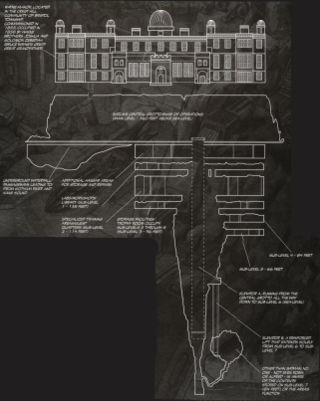
Plan of Wayne Manor displaying the Batcave below.
The method used to access it has varied across the different storylines in the comics, movies, and shows. In the comic books, it is typically accessible from a hidden door in Wayne Manor's study behind a non-functioning grandfather clock, which opens to a descending staircase when the hands on said clock are turned to 10:47 p.m., the time Thomas and Martha Wayne were killed.
The grounds also include a large hill that was partially hollowed out for Batman's aerial vehicles, and there is also an underground river system that is large enough to accommodate docking space for the Batboat and has a large opening for the boat and has a water fall.
In Other Media[]
Live-Action[]
Columbia Serials[]
| This section is a stub. You can help the Batman wiki by expanding it. |
Dozier television show[]
In the 1960s live-action series, the exteriors were shot at 380 S. San Rafael Dr. in Pasadena. The interiors were shot at various soundstages. Access to the Batcave: the primary passage was located in Bruce Wayne's study behind a bookshelf that retracted into the wall. The bookshelf was activated by a switch hidden in a bust of William Shakespeare. The bookshelf would disappear to reveal two labeled firepoles descending to the Batcave. For reasons never revealed, the poles allowed for Batman and Robin to inexplicably go from their civilian garb to costume (although the film based on the TV show displays a switch which does that).
Burton Films[]
In 1989's Batman, Knebworth House, a Gothic Tudor mansion 28 miles north of London was used for the exterior. The interior shots however, were filmed in the Hatfield House in Hertfordshire. The gaming room from the movie used the long gallery, and the marble hall was used for Wayne's 'arsenal' with the two-way mirror. The entryways into the Batcave are never explained in the original Warner Brothers movie.
In Batman Returns (1992), an entirely different estate landscape is shown, a fictional design drafted by Marty Kline with a hedge maze in the rear. A model is used for the exterior rather than location filming. The passage way to the Batcave is uncovered by turning on the lights of a nearby aquarium ornament, dropping through a false floor in an iron maiden rather than a grandfather clock stairwell in Wayne's study.
Schumacher Films[]
In Batman Forever (1995) and Batman & Robin (1997), Webb Institute in Glen Cove, New York was used for the exterior shots of Wayne Manor. In Batman Forever Dick Grayson discovers an entrance to the Batcave concealed behind a silverware storage cupboard that Alfred uses. Riddler later uses a hi-tech cane to find the same entryway.
The Dark Knight Trilogy[]
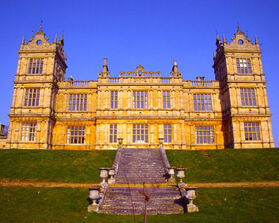
Wayne Manor as seen in Batman Begins.
In Batman Begins (2005), the former Rothschild estate, Mentmore Towers in Buckinghamshire, was used to portray Wayne Manor's exterior and interior. In Batman Begins, the main part of the mansion is destroyed by fire caused by Ra's al Ghul, however its foundation survives intact and rebuilding efforts are underway as the film ends, with Alfred suggesting to Bruce to make improvements on the mansion's southeast corner (where the Batcave is located). The secret passage is an elevator shaft originally built as part of the Underground Railroad, accessed by playing three notes on a nearby piano.
In The Dark Knight (2008), Wayne Manor is still being reconstructed, thus it is never seen. Bruce has moved to a penthouse and moved his equipment into a hidden bunker in the Gotham Docks. In The Dark Knight Rises, a reconstructed Wayne Manor is once again Bruce and Alfred's home. Wollaton Hall in Wollaton, Nottingham is used for exterior shots, a completely different design creating a discrepancy with Wayne's claim they he would re-build it "brick for brick" in the first movie.
Gotham[]
Wayne Manor features heavily in the TV series. The Webb Institute is once again used to represent it.
Snyder Films[]
The ruins of Wayne Manor are seen at several points in Batman v Superman: Dawn of Justice and Justice League. In the films, the manor was destroyed due to a fire started by the Joker, with Batman residing within a modern lakeside estate called the Glasshouse. Bruce visits the manors ruins on several occasions and dialogue in Justice League's epilogue implies that it will be transformed into the team's headquarters.
CW Shows[]
The "Earth-99" version of Wayne Manor appears in the second part of The CW's Crisis on Infinite Earths event. The manor is shown to have become a derelict ruin after Bruce Wayne's retirement. The manor is also decorated with trophies from many of Batman's victims, including the glasses of the universe's Superman.
The Batman[]
Wayne Manor appears once again appears in The Batman, though is heavily inspired by the Willowood estate. Transformed into an orphanage by Thomas Wayne, the home fell into disrepair due to Faclone's usage of donations to fund his activities. Edward Nashton is depicted as a former resident and he lures Batman to the manor's ruins to reveal his family's ties to Falcone's mob. It is unknown what happened to the place after Riddler’s flood.
Animation[]
Super Friends Animated DC Universe[]
Wayne Manor is rarely shown in Super Friends, the heroes pretty as always depicted in-costume at the Hall of Justice.
1992 DC Animated Universe[]
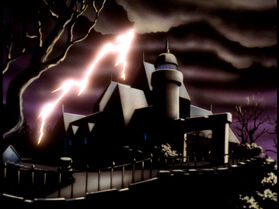
The version of Wayne Manor from Batman: The Animated Series.
In Batman: The Animated Series an address is given for Wayne Manor in the episode "The Demon's Quest" stating that it is located at 1007 Mountain Drive, Gotham. This version of the manor was built on a cliff overlooking the ocean. The design of the manor was inspired by art deco architecture, and when viewed from the sea, the vaulted frames of the roof resemble the pointed ears of the Batman symbol.
The Batman[]
In The Batman, Wayne Manor is depicted as a much taller building, with 7 floors. The initial entrance to the Batcave was hidden behind a video game machine, but following later seasons the entrance was replaced with the traditional grandfather clock. It is usually seen to be within Gotham city.
Batman: The Brave and the Bold[]
| This section is a stub. You can help the Batman wiki by expanding it. |
Beware the Batman[]
| This section is a stub. You can help the Batman wiki by expanding it. |
Video Games[]
Batman: Arkham Series[]
LEGO Video Games[]
| This section is a stub. You can help the Batman wiki by expanding it. |
Telltale Series[]
Trivia[]
- In Detective Comics #185 Batman kept a green disc in his Utility Belt thats states the adress of his estate as 224 Park Drive Gotham City.
- According to The Demon's Quest: Part I of the Animated Series, Wayne Manor's address is 1007 Mountain Drive.
- The lawns have large metallic underground plates that act as giant tazers for multiple intruders.
